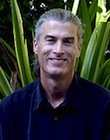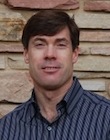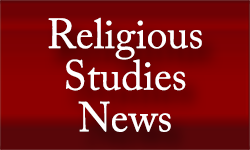|
 Kelly Bulkeley is a visiting scholar at the Graduate Theological Union in Berkeley, California. He earned his PhD in religion and psychological studies from the University of Chicago, MTS from Harvard University, and BA from Stanford University. He is a member of the editorial board of Pastoral Psychology, a senior editor for the American Psychological Association journal Dreaming, and a regular blogger for the Huffington Post. His books include The Wondering Brain: Thinking about Religion with and beyond Cognitive Neuroscience (Routledge, 2004), Dreaming in the World’s Religions: A Comparative History (New York University Press, 2008), American Dreamers: What Dreams Tell Us about the Political Psychology of Conservatives, Liberals, and Everyone Else (Beacon Press, 2008), and the co-edited volume Teaching Jung (Oxford University Press, 2011). He is the director of the Sleep and Dream Database (SDDb), an open-access digital archive and search engine designed to promote empirical research on dreams, psychology, and culture. Kelly Bulkeley is a visiting scholar at the Graduate Theological Union in Berkeley, California. He earned his PhD in religion and psychological studies from the University of Chicago, MTS from Harvard University, and BA from Stanford University. He is a member of the editorial board of Pastoral Psychology, a senior editor for the American Psychological Association journal Dreaming, and a regular blogger for the Huffington Post. His books include The Wondering Brain: Thinking about Religion with and beyond Cognitive Neuroscience (Routledge, 2004), Dreaming in the World’s Religions: A Comparative History (New York University Press, 2008), American Dreamers: What Dreams Tell Us about the Political Psychology of Conservatives, Liberals, and Everyone Else (Beacon Press, 2008), and the co-edited volume Teaching Jung (Oxford University Press, 2011). He is the director of the Sleep and Dream Database (SDDb), an open-access digital archive and search engine designed to promote empirical research on dreams, psychology, and culture.
Bulkeley has served in leadership positions in three AAR program units: As secretary-treasurer and newsletter editor of the Psychology, Culture, and Religion Group (1994–present), as steering committee member and then cochair of the Religion and the Social Sciences Section (2005–2012), and as steering committee member of the Cognitive Science of Religion Group (2006–2012). He recently served (2011–2012) as one of the first members of the AAR Program Committee specifically designated to represent the concerns of the program units.
Statement on the AAR
I'm grateful for the chance to offer my candidacy for Program Unit Director of the AAR, an organization that has supported my academic and professional development in countless ways. If elected to this position I would give special attention to three interrelated issues: Improving the quality of conferences, expanding resources fornon-traditional careers paths, and promoting greater technological fluency.
1) The annual and regional meetings are surely among the most important services provided by the AAR to its members. Mammoth operations to plan, organize, and produce these meetings are the lifeblood of the organization. Over many years of participation in various program units, I have gained a great deal of practical knowledge about what does and doesn’t work in our meetings process. Some of my goals—making sure the meeting venues are economical, accessible, and welcoming to newcomers and younger scholars—are straightforward and widely shared. Other goals—such as promoting livelier presentation formats that engage audiences better than conventional paper-reading sessions—are more aspirational and would involve significant changes to the culture of the AAR. I would look forward to leading conversations throughout the membership about the pros and cons of these kinds of changes.
A top concern in this regard has to be the growing number of AAR program units, which currently totals 148. At the present rate of adding new program units (about 4 per year), we will have over 200 by the middle of the next decade. This strikes me as unsustainable. The proliferation of program units confuses members, dilutes scholarly conversations, and strains the AAR’s resources for organizing the meetings. I don’t have an easy solution to these problems, but I’m sure we need to have a collective conversation about how best to address them.
2) In our present era of economic upheaval, particularly in the education sector, it is incumbent upon the AAR to devote special resources toward helping members navigate through an increasingly complex array of career options, publishing venues, and employment possibilities. As someone who has not followed a traditional professional path, I know how valuable the AAR can be in helping members cultivate research and presentation skills, build up knowledge across multiple domains, network with colleagues, meet book and journal editors, and make friends with kindred spirits. In a world where tenure-track faculty positions are a limited commodity, an increasingly valuable service for AAR members will be access to information about creative ways of applying religious studies scholarship in health care, public policy, non-governmental organizations, journalism, digital media, and other emerging professional arenas. The AAR already does a lot in this regard, and I want to advocate for even more.
3) In keeping with that, I would seek better ways of integrating new technologies into the work of the AAR. In recent years the AAR has made huge progress—first with OP3 and now with PAPERS—in its online proposal submission system. Many glitches remain to be fixed, but there are many more benefits to be derived from these technologies as well.
The potentials here go beyond streamlining administrative processes. Digital technologies and social media have already made an enormous impact on religious studies research and teaching. The AAR is perfectly positioned to provide its members with resources for taking advantage of these new developments. As an example of what’s possible, the 2013 annual meeting will offer an all-day workshop known as The Humanities and Technology Camp, or “THATCamp,” where participants will receive practical training in tools and methods that can enhance their religious studies scholarship. More programs like this will help AAR members across the professional spectrum make the best use of technological innovations in their fields.
|
 Greg Johnson (PhD University of Chicago) teaches in the Department of Religious Studies at the University of Colorado, where he is an associate professor and former chair. His research focuses upon contemporary indigenous traditions, particularly in their various intersections with nation-state political systems. Working in Hawaiian and American Indian contexts, Johnson studies repatriation and burial protection disputes, among other legally fraught and religiously revealing issues. He is currently finishing a book manuscript entitled Religion in the Moment: Contemporary Lives of Indigenous Traditions. Much of his teaching is focused on comparative studies and method and theory in the study of religion. Johnson serves on the editorial advisory board of History of Religions and on the editorial board of Religion Compass. Greg Johnson (PhD University of Chicago) teaches in the Department of Religious Studies at the University of Colorado, where he is an associate professor and former chair. His research focuses upon contemporary indigenous traditions, particularly in their various intersections with nation-state political systems. Working in Hawaiian and American Indian contexts, Johnson studies repatriation and burial protection disputes, among other legally fraught and religiously revealing issues. He is currently finishing a book manuscript entitled Religion in the Moment: Contemporary Lives of Indigenous Traditions. Much of his teaching is focused on comparative studies and method and theory in the study of religion. Johnson serves on the editorial advisory board of History of Religions and on the editorial board of Religion Compass.
Johnson has participated in meetings of the AAR in a range of capacities over the past twenty years. From 2004–2011 he served the Law, Religion, and Culture Group as a steering committee member and as cochair and chair. In these capacities, Johnson worked with numerous sections, groups, and seminars to facilitate cosponsored sessions, gaining experience with the mechanics of the AAR program construction process. Johnson has also worked with the international scholar program and the prison chaplaincy directors program of the AAR.
Statement on the AAR
What can we do, collectively, to ensure that the program of our annual meeting remains robust, inclusive, intellectually inviting and intellectually challenging? Answering this question deliberately is paramount. The program is, in effect, a real-time story we tell ourselves about who we are, and it is a story that others (e.g., the public, media, religious groups, other disciplines) attend to in a variety of sometimes perplexing ways. Given its status as our shared narrative, the program should not be a function of happenstance or reflect mere proliferation for plurality’s sake. It is a fact that “we” are an eclectic bunch with a peculiar and branching genealogy, and this yields our remarkably broad spectrum of interests. What we share, of course, is our varying degrees of interest in or affiliation with “religion.” In my view, our annual program should continue to make room for our manifold ways of engaging religion while establishing a level of intellectual coherence and acuity of vision that broadcast to the world how and why the AAR is the global center of the study of religion. Kudos goes to past program committees for laying a foundation for this double agenda. The charge of this position, as I would embrace it, is to continue to facilitate this effort.
I welcome the opportunity to learn about and carry forward initiatives put in place by previous program committees and program unit chairs. I am also enthusiastic about the chance to make a few targeted adjustments to how we deliver our program and to what audiences. For instance, I plan on continuing to reach out to affiliated organizations to which our collective futures are tied, including the SBL and the IAHR. Another agendum is brainstorming with AAR members about ways to reach out to mid- and late-career scholars. With the current levels of fierce program slot competition, coupled with rising costs of attending meetings, I worry that our seasoned colleagues are losing motivation to attend the annual meeting. Their absence leads to an imbalanced meeting and thus to inaccurate representations of the state of the field. I would also work hard with our international colleagues to explore ways to maximize their involvement in our meetings. Another issue I find compelling is the effort currently underway to create and sustain user-friendly platforms for distributing papers electronically in advance of meetings and means for engaging one another about session and paper topics in the wake of meetings. I am also eager to work with the leadership of the AAR to rethink our scheduling practices. Tuesday Morning should forever remain the name of a discount clothing store, not a sinking feeling one gets upon finding one’s session on the last page of the program.
Finally, I would look to other organizations’ meetings for inspirational best practices. The Law & Society Association, for example, does a remarkably good job of bringing nonacademics into its conversations, giving their meetings a palpable this-worldly quality. Religion matters on the streets, in the courts, and in the press. This social fact should be reflected and—analytically, at least—directed by us. The AAR already does this in numerous ways, but we have room to grow the program in this regard. Another example comes from the Native American and Indigenous Studies Association, which is a runaway success despite being only five years old. Precocious! Their meetings foster a profound sense of shared intellectual and social purpose. We need to foreground this element of what we do, breaking through calcified layers of habit in the process. Great meetings should provoke “ah ha” moments for the greenhorn and the veteran alike.
|


 Kelly Bulkeley is a visiting scholar at the Graduate Theological Union in Berkeley, California. He earned his PhD in religion and psychological studies from the University of Chicago, MTS from Harvard University, and BA from Stanford University. He is a member of the editorial board of Pastoral Psychology, a senior editor for the American Psychological Association journal Dreaming, and a regular blogger for the Huffington Post. His books include The Wondering Brain: Thinking about Religion with and beyond Cognitive Neuroscience (Routledge, 2004), Dreaming in the World’s Religions: A Comparative History (New York University Press, 2008), American Dreamers: What Dreams Tell Us about the Political Psychology of Conservatives, Liberals, and Everyone Else (Beacon Press, 2008), and the co-edited volume Teaching Jung (Oxford University Press, 2011). He is the director of the Sleep and Dream Database (SDDb), an open-access digital archive and search engine designed to promote empirical research on dreams, psychology, and culture.
Kelly Bulkeley is a visiting scholar at the Graduate Theological Union in Berkeley, California. He earned his PhD in religion and psychological studies from the University of Chicago, MTS from Harvard University, and BA from Stanford University. He is a member of the editorial board of Pastoral Psychology, a senior editor for the American Psychological Association journal Dreaming, and a regular blogger for the Huffington Post. His books include The Wondering Brain: Thinking about Religion with and beyond Cognitive Neuroscience (Routledge, 2004), Dreaming in the World’s Religions: A Comparative History (New York University Press, 2008), American Dreamers: What Dreams Tell Us about the Political Psychology of Conservatives, Liberals, and Everyone Else (Beacon Press, 2008), and the co-edited volume Teaching Jung (Oxford University Press, 2011). He is the director of the Sleep and Dream Database (SDDb), an open-access digital archive and search engine designed to promote empirical research on dreams, psychology, and culture. Greg Johnson (PhD University of Chicago) teaches in the Department of Religious Studies at the University of Colorado, where he is an associate professor and former chair. His research focuses upon contemporary indigenous traditions, particularly in their various intersections with nation-state political systems. Working in Hawaiian and American Indian contexts, Johnson studies repatriation and burial protection disputes, among other legally fraught and religiously revealing issues. He is currently finishing a book manuscript entitled Religion in the Moment: Contemporary Lives of Indigenous Traditions. Much of his teaching is focused on comparative studies and method and theory in the study of religion. Johnson serves on the editorial advisory board of History of Religions and on the editorial board of Religion Compass.
Greg Johnson (PhD University of Chicago) teaches in the Department of Religious Studies at the University of Colorado, where he is an associate professor and former chair. His research focuses upon contemporary indigenous traditions, particularly in their various intersections with nation-state political systems. Working in Hawaiian and American Indian contexts, Johnson studies repatriation and burial protection disputes, among other legally fraught and religiously revealing issues. He is currently finishing a book manuscript entitled Religion in the Moment: Contemporary Lives of Indigenous Traditions. Much of his teaching is focused on comparative studies and method and theory in the study of religion. Johnson serves on the editorial advisory board of History of Religions and on the editorial board of Religion Compass.